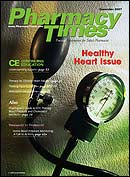Publication
Article
Pharmacy Times
Complementary and Alternative Options Pose Risks
Pharmacists are an important source of drug interaction information for patients wishing to use complementary and alternative medications. In addition to discussing the possible benefits, the pharmacist can carefully evaluate the patient's medical record for potential interactions.
Drs. Horn and Hansten are both professors of pharmacy at the University of Washington School of Pharmacy. For an electronic version of this article, including references if any, visit www.hanstenandhorn.com.
Complementary and alternative medicines (CAMs) have found a wide following, with more than 15% of the US population taking these products during any week.1 It has been estimated that between 6% and 15% of these patients are concurrently taking prescription medications.2 Potential interactions in this group of patients most frequently involve aspirin, nonsteroidal anti-inflammatory drugs, or warfarin combined with complementary products having antiplatelet or anticoagulant effects, such as ginkgo or willow bark. A survey of patients attending anticoagulation clinics found that more than 30% regularly consumed nonvitamin dietary supplements, including fish oils, glucosamine-chondroitin, cranberry extract, coenzyme Q10 (CoQ10), green tea, and grapefruit extract.3
Patients taking warfarin or other drugs with narrow therapeutic ranges may be particularly at risk to develop adverse interactions with CAM therapies. In a study of patients taking chronic warfarin, 43% noted coadministration of CAMs reported to interact with warfarin during the 15 weeks of data collection. CAMs associated with an increased risk of bleeding included cayenne, willow bark, St. John's wort, ginger, and CoQ10. The last 2 were identified as risk factors after all (both CAM and non-CAM) risk factors were considered.4
A recent report noted an elevated international normalized ratio (INR) in a patient stabilized on warfarin who began ingesting chitosan 1200 mg twice daily.5 A dechallenge and rechallenge with chitosan appeared to confirm the interaction. Chitosan is suspected to affect vitamin K absorption from the gastrointestinal tract. In another report, a patient noted an elevated INR and minor bleeding after several days of ingesting grapefruit seed extract.6 The extract and 2 additional brands of it were analyzed and found to contain no grapefruit seed extract. It did contain benzathonium chloride that was subsequently found to inhibit CYP2C9 and CYP3A4, the enzymes primarily responsible for warfarin's metabolism. This case reminds us of the unregulated nature of many CAM products and that the suspected mechanism of an interaction may not be what it appears.
While case reports of CAM?warfarin interactions are occasionally published, an online registry (see www.clotcare.com) has been established to collect cases of altered warfarin response due to CAM therapy. Potential interactions will be evaluated using a modification of the Drug Interaction Probability Scale.7 Pharmacists and other practitioners should report any suspected interactions between warfarin and CAMs. The registry is an important step to further our understanding of interactions between CAMs and warfarin.
Patients with diabetes also have been identified to be at risk of CAM interactions. In a study of 800 outpatients, 15% admitted using CAMs. Of the CAM users, 40% had potential drug interactions, and 7% had adverse interaction outcomes.8 The most common potential interactions involved nopal (prickly pear cactus) and oral hypoglycemic agents. Eight of the 12 interactions observed in this study resulted in hypoglycemia and occurred in diabetics taking nopal and metformin (eg, Glucophage) or glyburide (eg, Diabeta). The mechanism of this purported interaction is unknown; however, limited studies with nopal have noted some hypoglycemic effect. No drug interaction studies appear to have been published with nopal and oral hypoglycemic agents. Pharmacists should counsel diabetics using nopal with conventional therapy to monitor for hypoglycemic episodes.
Some diabetics test their blood sugar levels with test strips containing the enzyme glucose dehydrogenase pyrroloquinolinequinone (GDH-PQQ). The Free- Style and Accu-Chek systems utilize this enzyme. The administration of galactose and xylose can cause elevated glucose readings when the blood is checked using GDH-PQQ?containing systems.9 Both of these agents are known as glyconutrients and can be obtained from health food suppliers. Galactose is usually found combined with glucose to form the disaccharide lactose and is primarily found in dairy products. Galactose has been claimed to inhibit tumor growth and promote wound healing. Xylose is a nonabsorbable molecule that has been claimed to reduce the risk of gastrointestinal tract cancers and reduce blood cholesterol. Patients ingesting galactose or xylose may record falsely elevated glucose readings on their test strips. Adjustment of insulin doses in response to these readings could lead to serious hypoglycemic episodes.
The utilization of CAMs, alone and concurrently with prescription medications, will likely continue to increase. Pharmacists are an important source of information for patients wishing to use CAMs. In addition to discussing the possible benefits of CAMs, the pharmacist should carefully evaluate the patient's medication record for potential interactions.
References
- Kaufman DW, Kelly JP, Rosenberg L, Anderson TE, Mitchell AA. Recent patterns of medication use in the ambulatory adult population of the United States: the Slone survey. JAMA. 2002;287:337-344.
- Elmer GW, Lafferty WE, Tyree PT, Kind BK. Potential interactions between complementary/alternative products and conventional medicines in a medicare population. Ann Pharmacother. 2007;41:1617-1624.
- Wittkowsky AK, Bussey HL, Walker MB, Frei CR. Dietary supplement use among anticoagulation clinic patients. J Thromb Haemost. 2007;5:875-877.
- Shalansky S, Lynd L, Richardson K, Ingaszewski A, Kerr C. Risk of warfarin-related bleeding events and supratherapeutic international normalized ratios associated with complementary and alternative medicine: a longitudinal analysis. Pharmacotherapy. 2007;27:1237-1247.
- Huang SS, Sung SH, Chiang CE. Chitosan potentiation of warfarin effect. Ann Pharmacother. 2007;41:1912-1914.
- Brandin H, Myrberg O, Rundlof T, Arvidson AK, Brenning G.. Adverse effects by artificial grapefruit seed extract products in patients on warfarin therapy. Eur J Clin Pharmacol. 2007;63:565-570.
- Horn JR, Hantsen PD. DIPS: a tool to evaluate causation in potential drug interactions. Pharmacy Times. 2007;73:84.
- Bush TM, Rayburn KS, Holloway SW, et al. Adverse interactions between herbal and dietary substances and prescription medications: a clinical survey. Altern Ther Health Med. 2007;13:30-35.
- Schleis TG. Interference of maltose, icodextrin, glactose, or xylose with some blood glucose monitoring systems. Pharmacotherapy. 2007;27:1313-1321.







